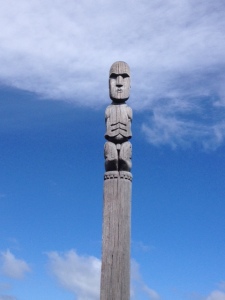“Miss, do they have fish and chips in the US?” To many this may not seem like a very exciting question. But to me it was a fantastically exciting one. One of the young people that I have been working with here in NZ posed this question to me the other day, and for me it carried a much deeper meaning than one might think.
Before I explain, let me backtrack a bit…
In my first four weeks in New Zealand I have had the strange feeling that every time I enter a conversation with someone or visit my educational policy class, the theme of identity keeps resurfacing – in one form or another.
Here are a few examples…
On my first visit to my new “home” at the university, I had the pleasure of meeting one of the instructors of a course that I will start visiting next week called “Matauranga Māori in Education” (Matauranga = understanding or knowledge). Something that she talked about really resonated with me: the importance of helping Māori children to understand who they are and where they come from. A few days later Jessie and I hosted a birthday party for our new friend Sarah. At our party I met many nice, young Kiwis, but one guest in particular, Nathan, has left such a lasting impression. Only after a few minutes of introducing himself Nathan told me proudly about his Māori heritage. And by the end of the night he was singing beautiful traditional Māori songs for us. The deep emotion with which he sang told me that being Māori is a major part of his identity. Last week one of Jessie’s new colleagues and friends was kind enough to take us out for a drive around Wellington and the surrounding areas. At each stop he told us wonderful stories of the Māori leaders of the past and their strength and will to survive. These stories have been passed down from generation to generation and clearly play an important role in helping young people understand where they come from.

Totem poles like this one in the Whitireia park reserve in Titahi Bay were used to communicate stories before te reo Māori was a written language.
My exposure to the topic of identity has not been limited to Māori identity, however. In my readings about intercultural competence and conversations with people interested in my project topic the issue of identity and understanding oneself always comes up. In my many enjoyable afternoon conversations with my advisor Eric Yates, Eric has reminded me what happens when students learn another language in a setting in which there is a dynamic relationship between language and culture (i.e. learning about another culture in the language). Not only do students learn to communicate and learn about the culture and values of another group of people, but they also develop a better understanding of themselves and their own culture. (for those of you interested in reading more about the concept of interculturality, I highly recommend reading the summary of the Newton Report written by Johnathon Newton, Eric Yates, Sandra Sheam, and Werner Nowitzki. It is a document used to introduce language teachers in New Zealand to the concept of intercultural communicative language teaching and learning).
All of these experiences and conversations have led me to place the concept of identity into the context of my project here. In thinking about what young people today will need to succeed in a global community, I am convinced that a stronger sense of who they are and where they come from will benefit them. When students are exposed to the values, customs, and perspectives of another culture they hopefully will begin to start questioning their own. They might realize that somethings they have taken for granted their whole lives are not the same in other parts of the world. Hopefully, the end result is more tolerance for others and ultimately will make them more effective communicators and collaborators.
Theoretically, it all sounds so easy. But asking students to dig deeper below the surface of what they like to eat and what they like to do in their free time is quite a challenge. American teenagers often tie their identity to their favorite sports team or their favorite music group. Or when asked about their heritage, they say “I’m 1/4 German and 3/4 Irish.” But do they know the stories of what their ancestors went through to survive in the US? And more importantly, do all young people feel comfortable talking about their identity if it isn’t one that is seen as part of the mainstream?
Now allow me to fast forward to: “Miss, do they have fish and chips in the USA?”
The young man who asked me this question was working on a presentation in German about himself, which he would send to my students in the US. He wanted to write about his favorite food – fish and chips. This simple question showed me that he was starting to dig below the surface and think on a deeper level about the values and customs of his own country. He was beginning to understand that one cannot assume that values and customs are universal.
The reality is that in ten years many of our students will find themselves in situations in which they will need to know how to communicate and collaborate with people from other countries – whether that be in their native language or another language. So why not give them opportunities now to engage in meaningful conversations with their peers in other countries? They not only will gain a better understanding of another culture but also of themselves.
